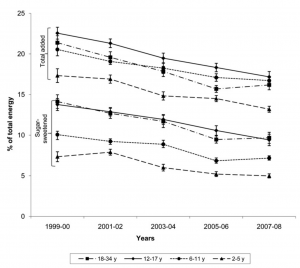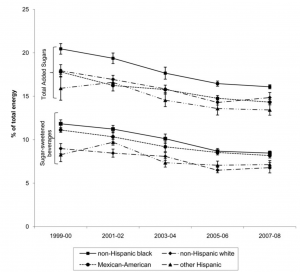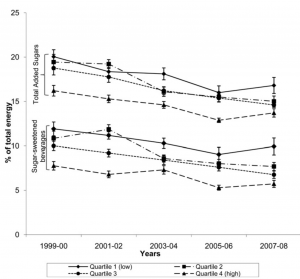 Consumption of sugar may be a primary driver of obesity. There is a clear metabolic pathway that shows the ability of sugar to cause the development of insulin resistance and the accumulation of body fat. Animals models and human clinical trials suggest that refined carbohydrate and sugar are associated with the development of insulin resistance and weight gain. Sugar refers nutritionally to sucrose, a disaccharide molecule composed of both fructose bonded to glucose. However, other sweeteners are also loosely called sugar. High fructose corn syrup (HFCS) is also composed of fructose and glucose, but in this case the molecules are free in solution, and are not bound. Evidence suggests that high fructose corn syrup can be just as detrimental to the health, and is more commonly used to sweetened soft drinks in the United States, compared to sucrose in European countries. It is likely the fructose component of these drinks that is the main driver of weight gain, although other factors should be considered.
Consumption of sugar may be a primary driver of obesity. There is a clear metabolic pathway that shows the ability of sugar to cause the development of insulin resistance and the accumulation of body fat. Animals models and human clinical trials suggest that refined carbohydrate and sugar are associated with the development of insulin resistance and weight gain. Sugar refers nutritionally to sucrose, a disaccharide molecule composed of both fructose bonded to glucose. However, other sweeteners are also loosely called sugar. High fructose corn syrup (HFCS) is also composed of fructose and glucose, but in this case the molecules are free in solution, and are not bound. Evidence suggests that high fructose corn syrup can be just as detrimental to the health, and is more commonly used to sweetened soft drinks in the United States, compared to sucrose in European countries. It is likely the fructose component of these drinks that is the main driver of weight gain, although other factors should be considered.
If obesity rates are increasing in Western nations, it might be expected that sugar consumption was also increasing. In fact this is often what is implied within discussions regarding the implementation of sugar taxes. However, the data clearly shows sugar consumption has been declining in the United States during the same period that obesity rates have been rising. This paradox has also been described in Australia and the United Kingdom. If rates of obesity are increasing, but sugar consumption is declining, this suggests that sugar taxes designed to reduce consumption of sugar may not be effective at controlling obesity. One suggestion could be that there exists a particular threshold of sugar consumption above which weight gain develops. It may be that per capita sugar consumption is still above this level even with falling consumption, and therefore obesity rates have continued to rise. If this is the case larger reductions in sugar intake might be required to have the desired effect on obesity rates.

Consumption of total added sugars and sugar sweetened drinks by age in the United States (Welsh et al., 2011).

Consumption of total added sugars and sugar sweetened drinks by race in the United States (Welsh et al., 2011).

Consumption of total added sugars and sugar sweetened drinks by socioeconomic status in the United States (Welsh et al., 2011).
Eat Well, Stay Healthy, Protect Yourself
RdB
